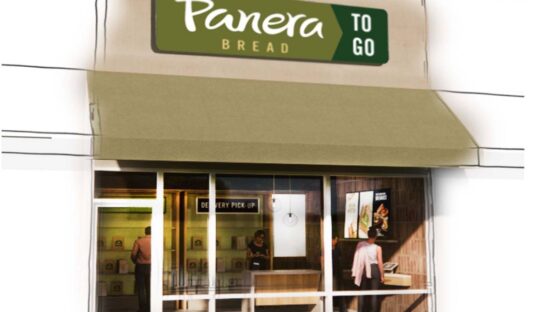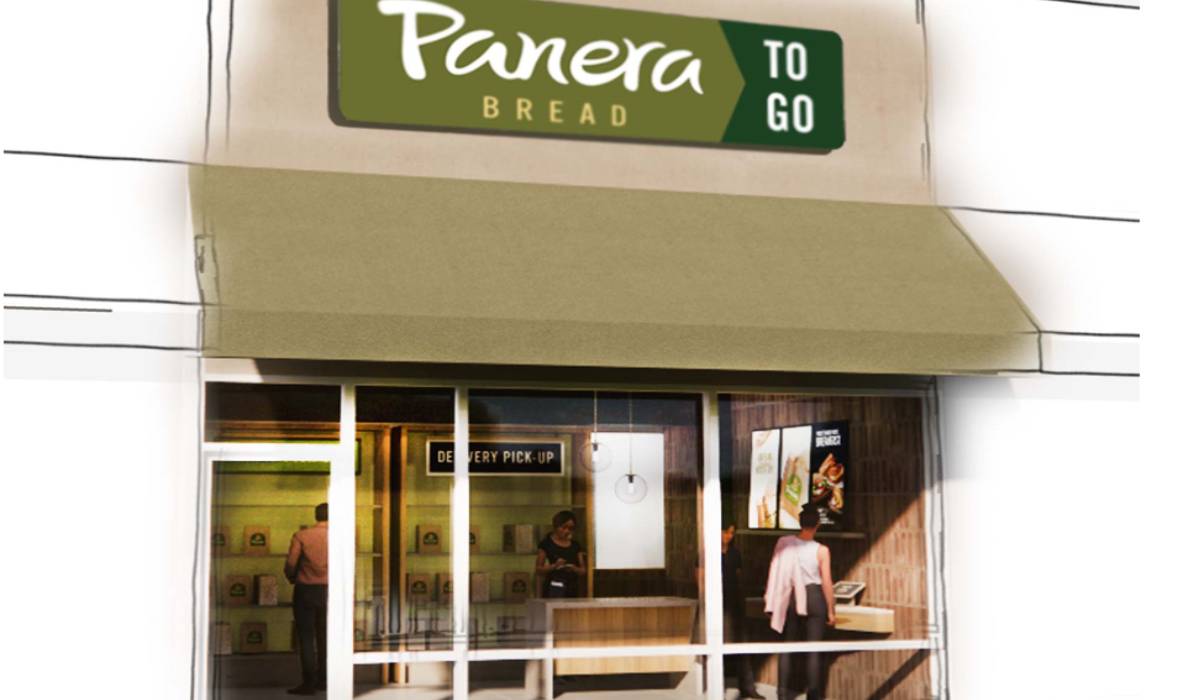Panera set the standard of where expansion is headed with its NextGen bakery-cafe.
The slimmed 3,500-square-foot prototype—debuting in November—features a double drive-thru, with one lane specifically for mobile orders. The store leverages geofencing technology to immediately identify MyPanera loyalty members, allowing employees to greet customers by name and have special deals prepared. Guests are also able to order via Rapid Pick Up, curbside, digital kiosk, at the counter, and a contactless dine-in option through the app.
The impetus, of course, was the growth of off-premises. The channel accounted for 81 percent of sales last year, including a threefold increase in delivery (drive-thru is mixed in as well). Almost half of the off-premises business comes through digital orders.
“People are definitely migrating back to dine-in, but what we’re seeing is, this is creating an incremental opportunity for us because it’s now an additional access point for our guests,” says Chris Correnti, SVP of off-premises channels. “So for us, we see it as an incredible convenience play for our guests that they get to pick whichever way that they want to come in. We don’t see any of those channels as something that they tried and now they’re going back to the old way. What we’re actually seeing is, it’s part of their consideration set and depending on what the use case is, they determine which channel will best suit them for how they want to be served.”
The reality, however, is that NextGen cafes can’t fit into all trade areas. As Panera observed customers retaining their off-premises muscle memory, it prioritized implementing the same level of convenience, but in an underserved, urban market—places previously beyond the fast casual’s reach because of real estate availability or cost.
Brainstorming sessions translated to Panera To Go, a prototype fit for a more densely populated surrounding. The 2,500-square-foot restaurant is completely digital, meaning customers can only order ahead through the web and app. The first unit opened in May and is housed in Chicago’s Edgewater neighborhood.
“While our primary focus is always to put a traditional Panera bakery-cafe in there with a drive-thru, it was not afforded to us [in urban markets] because of space costs and actually the overall demand,” Correnti says. “But by building this Panera To Go, it allowed us to get into a smaller space with very different economics, and it was a space that we weren’t servicing our guests very well.”
“For us right now, as we look at these locations, we are seeing [urban] recovery without a doubt,” he adds. “We do have other locations, another one that’s approximately 4 miles away. But we were not satisfying this particular trade area very well.”
In the past couple of years, a number of brands have opted to remove the dining room, including Chipotle, Jimmy John’s, Sweetgreen, Wingstop, Captain D’s, and Tim Hortons. The trend hasn’t been lost on casual dining either. Many full-service chains have opted to open to-go locations, like Buffalo Wild Wings and P.F. Chang’s.

Two more Panera To Go stores are scheduled to open in Southern California and Washington, D.C. later this year. Correnti says the chain is also exploring New York City. When customers or third-party delivery drivers enter, they simply walk to pick up their order from to-go shelves. The restaurant will serve all dayparts, and may potentially add digital kiosks and a catering channel in the future.
These initial restaurants will be corporately owned. After evaluating results, franchisees may open their own digital-only locations. Panera has about 2,100 restaurants in 48 states and Ontario, Canada, with close to a 50/50 split between franchises and company-owned units.
Sales volumes will depend on the market, but won’t be the same as a traditional suburban outlet. Although Correnti couldn’t go into too much detail, he notes Panera has a “very clear indicator” of what it needs to do from a sales perspective, and the brand is optimistic about the new prototype’s potential. With the vast majority of staff placed in the back of house, the unit is able to leverage labor costs that are multiple times fewer than a traditional bakery-cafe. Also, due to its size, buildout costs are lower.
“Because of all those different factors, our average weekly sales hurdle is very different than a traditional cafe,” Correnti says. “ … We’ve opened up one of them and we love the insights that we’ve heard so far and how our guests want to experience our products, whether it’s through pickup or delivery and how they’re embracing that digitally enabled only contact. So as we learn more through this process, we’re going to expand it. We’re going to expand, whether it’s going to incorporate kiosks or if there’s a market need for catering, we want to incorporate that in there also.”
Currently, Panera has roughly 86 cafes in urban markets. The chain believes it can double that presence, and it will leverage multiple store types to do so. If the brand is unable to enter an area with its NextGen cafe and double drive-thru, it turns to a slightly smaller urban-centric unit with limited seating and a cashier. In scenarios where that design doesn’t work, Panera will flex down to its digital-only prototype.
The final path is ghost kitchens, which have provided a significant amount of insight as to how operations work best in a strictly digital environment—learnings that were used while Panera developed its to-go-only store. There are five ghost kitchens open, and six more will make their debut before 2022 concludes.
Correnti says that at its core, Panera is about the fireplace and sense-tingling bakery that greet customers in the dining room, but the chain’s commitment to off-premises dates back years before the pandemic arrived.
Rapid Pick Up launched nationally in 2016, and just a couple months after nationwide shutdowns in the spring of 2020, the brand rolled out curbside pickup. Additionally, by the end of 2021, 44 percent of restaurants included a drive-thru.
Because of that history, opening Panera To Go wasn’t a heavy lift in terms of digital infrastructure. It’s just a matter of real estate and filling in holes where demand is unmet.
“It’s a way for more guests to get access to the food that we serve—which is clean, freshly prepared—in the areas that we haven’t been able to get to in the past,” Correnti says. “So our guests have created these new habits over the past two years, and one of them is more off-premises dining. We’re in a good position to take advantage.”











